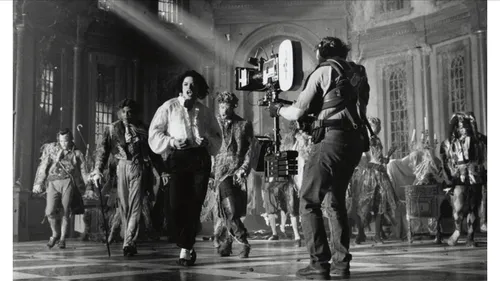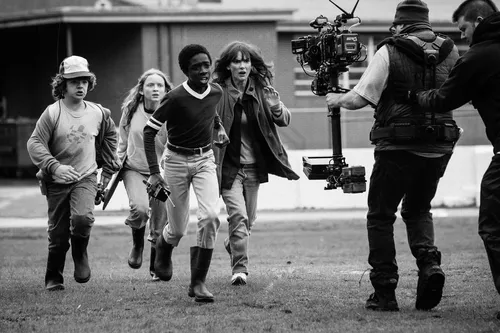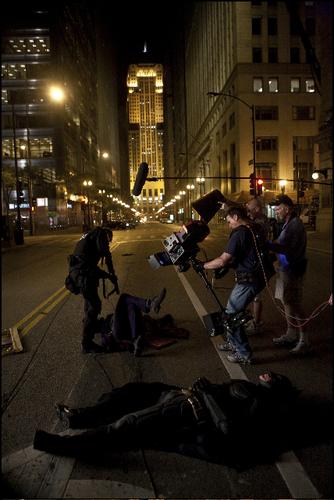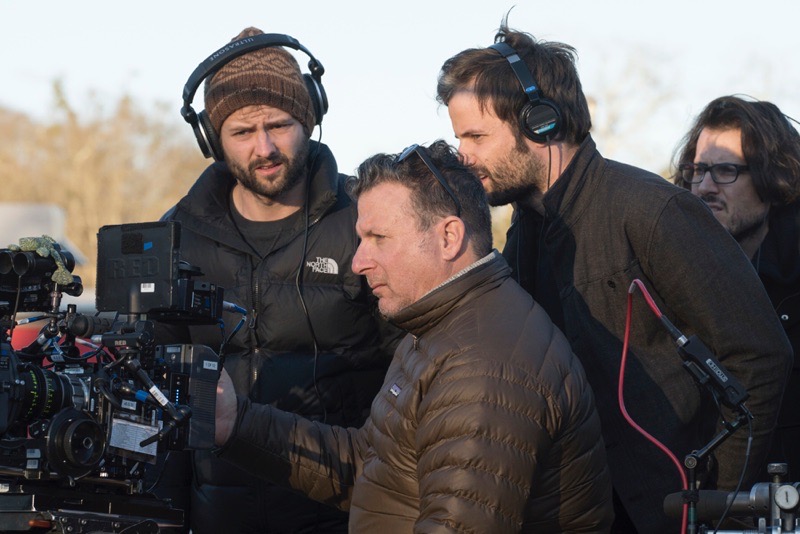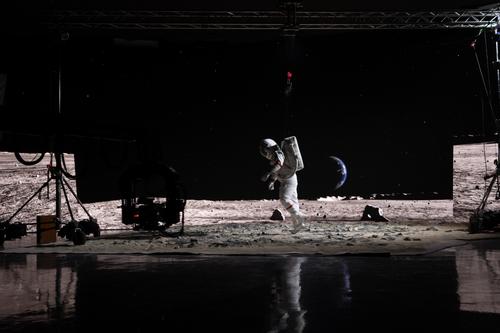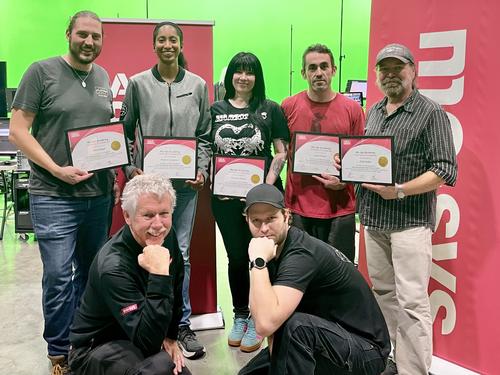Bob Gorelick - “It’s a beautiful dance”
Bob Gorelick’s journey from Steadicam to remote heads
Remember that time when Jules and Vincent were walking down the corridor, chatting about “foot massages” on their way to pick up Marseullus’ briefcase? What about that time Heath Ledger crashed the party to tell Maggie Gyllenhall how he got those scars? Or when four boys ventured out into the pouring rain at night and discovered a girl with a shaved head in the woods? Yep. All Bob Gorelick. A quick scan of his IMDB page tells you that, as a Steadicam and A-camera operator, Bob has shot some of the most iconic moments in modern cinema and television.
Bob has hung up his Steadicam for the last time, but he is still operating and has swapped the vest for a set of handwheels. We stopped by to talk with him about his career and his adoption of remote heads.
“I got into Steadicam back in 1987, in New York, where I was starting out in the industry. While I was working as a second assistant and then a focus puller, I worked with some Steadicam operators, and it really intrigued me, so it was something I decided to pursue.”
Something that becomes quite clear about Bob is that his career is peppered with moments of curiosity, where a piece of new technology catches his eye, and he embraces it wholeheartedly.
La La Land
“After four or five years of working in New York, I moved to Los Angeles, with the hope, or maybe dream, of working on bigger movies, but fortunately I did, through my speciality with Steadicam.”
The other thing that one quickly notices about Bob is the charming and often understated way that the two-time winner of the Society of Camera Operators’ ‘Camera Operator of the Year Award’ talks about himself. It was talent, rather than fortune, that has landed him the big jobs, seeing him work with great directors, from Quentin Tarantino and John Carpenter to Paul Thomas Anderson, James Cameron and Christopher Nolan, but we’ll let him tell it his way…
“By the time I got to Los Angeles, Steadicam had started to evolve, not because of me, but rather because of the way directors wanted to use the tool. For a long time, it was taken on as a daily hire for specific shots, but then directors started liking the idea of having a Steadicam on hand at all times. This was great because it allowed people like myself to work on an entire movie or project and become a consistent part of the team.”
This new trend for having Steadicam permanently on-set allowed Bob to cement his position within the Hollywood pool of camera operators, as Bob goes on to explain.
“From having a Steadicam operator on set at all times, the next logical progression was to have that person operate the ‘B’ camera. So, I started operating conventional camera as well, and then eventually that led to being the A-camera/Steadicam operator.”
Moves
Firmly established on Hollywood film sets as a go-to Steadicam/A-camera operator, Bob’s curiosity was once again piqued.
“My introduction to remote heads started in the early 90s with the advent of the techno crane. I think the first one I ever saw was made by Matthews. Again, they always intrigued me – just the types of moves you can get off a jib arm or a crane were always very cinematic and exciting for me. As time went on, techno cranes and remote heads became a standard tool carried on film and television sets. I think I first encountered ‘the Mo-Sys’ in the late 90s when one of the early fluid heads was brought onto set whilst I was a ‘B’ camera operator.”
Like the Steadicam before it, remote heads were starting to become a standard tool on-set.
“As time went on, remote heads started being rented on a weekly basis rather than a daily basis for a lower rental price, so at some point I decided to get into remote head work.”
Upping the Tempo
Another major technical shift that affected the entire film and television industry was the rise of digital, and with it, the presence of Steadicam and remote heads on-set became the rule, rather than the exception
“The business has evolved to a point where the days of planning for a specific shot are kind of over. Directors want the option to do almost anything that they can imagine, at all times, and no one wants to wait for anything in this business. Tools like the Steadicam, remote heads and techno cranes make that possible and affordable.”
In the early phase of Bob’s adoption of remote head shooting, he would use it for a limited range shots, as he explains.
“When I was shooting film, it was really just used for specific tasks. Most of the time it would be for shots that were either very low to the ground, or very high looking down, for example, jib arm, or putting the L40 on a high hat on a ladder, so I didn’t have to have to stand up that ladder for 40 minutes.”
Singing from the Same Hymn Sheet
Bob continues, discussing how the digital transformation pushed him to lean towards remote heads more and more.
“As we got deeper into digital cinematography, where the way that we worked was getting faster, the way operators communicated with the directors and the DoP was changing. They were no longer always on-set. They were over at Video Village, maybe thirty, forty, fifty feet away, or in a different room completely, and I wasn’t getting the feedback I needed when I was on-set. So, with everybody starting to work remotely and communicating via headsets, that whole process led me to really think that I could actually operate remotely too. I could be physically closer to the creative nucleus and not necessarily have to be on set, which made the communication process a lot easier.”
Over the years, the remote head has become Bob’s first choice, not just for better communication, but for the convenience of his DoPs as well.
“I think that my desire to use the remote head for almost everything started about five years into my digital career,” he chuckles. “There’s a different approach with digital. Different techniques and protocols. In the new digital world, DoPs are lighting through the camera. They’re at a high-quality video monitor, and they’re lighting from there, so the camera needs to be set up and stationary for them to do that.”
Beyond grip equipment and remote heads, the shift to digital led to a fundamental change in the way operators conduct their craft.
“I don’t know many operators who use the eyepiece anymore, because the eyepieces are all electronic. They’re small, the image is noisy and, well… not very good. Most operators are using at least seven-inch HD monitors. With the remote head I can have a bigger monitor. I don’t like to go too large, because you’re not able to see everything that’s in the frame, but a 13-inch, 4K monitor is a blessing for me to work with because I can see a lot more detail.”
The Big Number
Bob’s eye for detail when it comes to resolution and new technologies has placed him at the forefront of the next format revolution.
“I was invited to join the 8K Association to bring in the perspective of someone with a non-engineering background, as someone who uses the equipment. My cousin, Marc Finer, worked at Sony for decades, and he’s one of the leaders of the movement.”
Bob’s acknowledgement that his cousin invited him to join underplays the significance of his role in the organisation and his expert knowledge of big formats. Bob is, after all, one of the few operators with the questionable honour of having wielded an IMAX camera on the Steadicam.
“I’m really grateful that I had the opportunity to work with IMAX. I loved doing it. The weight challenge was there, but it’s something that you get used to. It’s doable.”
For Christopher Nolan’s epic ‘The Dark Knight’, 28 minutes of the feature’s final runtime was shot on IMAX, and Bob was the one tasked with wielding the massive camera rig.
“Steadicam has become so commonplace now that filmmakers often take it for granted, and you end up standing around quite a bit, holding it, waiting for other things to fall into place. That wasn’t the case with IMAX. One of the good things about flying a large format camera is that the people you’re working for are, I would say, ‘a little more patient’ and ‘understanding’ about what you’re doing,” he laughs. “Chris Nolan and his team were very supportive and appreciative and really understood the task that I was undertaking.”
The Two-Step
As Bob continued to rely more and more on remote heads, he finally made the big decision.
“So, around 2017, I decided to purchase the L40. There was an overlap there of a couple of years where I was still operating both Steadicam and the L40, but when I turned 60, I decided not to operate Steadicam anymore. It was just too hard on me, physically, so now it’s just ‘the Mo-Sys’. I’m now 65, and still shooting, so actually, having the remote head has enabled me to have another opportunity to own something that I can rent to the production, to supplement my operating income, just as the Steadicam did for so many years.”
With his Steadicam hung on its stand for the last time, Bob uses remote heads almost exclusively, since there are, after all, some additional benefits, Bob explains, with a naughty glint in his eye.
“I had a director, Shawn Levy on ‘Stranger Things’, ask me why I was operating from the remote head so much, and I said to him that I feel like I can work much more efficiently when I’m not tied to the dolly, and I really do. There’s a selfish aspect to that, too, though… The set is hot, and that house is tiny! I don’t necessarily have to be in there! I can get comfortable,” Bob laughs.
No more Acrobatics
With the L40, Bob has found that he has the best of both worlds, so he can still be on set when necessary.
“What I love about the L40 is that now I can go with the remote head and still be on set. The equipment is so compact and easy to set up that I can put the console on baby legs and tuck myself into a corner, sit on an apple box and not have to be on the dolly. What that does for me is take the contortionism out of operating the shot. You might have a shot that starts low and then jibs up with a 200o pan, but now I don’t have to climb all over the dolly. That’s a big benefit anyway, but at sixty years old, that’s a huge benefit! My assistants are trained on the head, so they can move it around and set it up within minutes. It’s now the way I prefer to work.”
Dance like Nobody’s Watching
Beyond the technical and practical benefits, Bob’s kindness shines out as he discusses how he uses the remote head to help the actors on those scenes everyone hates to shoot.
“My preference is to work with the remote head as much as possible, and a lot of my colleagues are also going to remote heads, but it’s not just about convenience. There was a show that I worked on for two seasons called ‘Tell Me Lies’ on Hulu. It’s a show about college kids coming of age, and there were a lot of sex scenes in the show, especially in Season One, where they were very graphic. I found that it was a much more polite way to shoot, without me having to be in their faces with the camera, or even on-set. I could be off set and allow them the freedom and privacy to do their work.”
Taking the Lead
This leads Bob into a wider discussion on how remote head work helps with his overall approach to working on-set.
“Everybody’s different in their operating approach. I was trained, and still believe that, as crew, we should be as invisible as possible. So, I’ve never really been one to chat with actors - particularly when they’re on-set. It’s a very touchy thing because some actors are method acting and they’re in character and they really don’t want to be distracted. A lot of directors don’t like it when operators talk to their actors while we’re on set, either. Some don’t mind, but most of the ones I’ve worked with prefer that that doesn’t happen.”
Using a remote head as the standard mode of shooting allows Bob to maintain this professional distance from the actors far more easily than it was back in his Steadicam days, when he had a much greater physical presence on the set.
“As an operator, I pop into the room occasionally to investigate something that didn’t work or communicate with somebody who’s not on the headsets. I might have to talk with the boom operator or a lighting technician, so the actors know who I am, and if they want to, of course, they can talk to me. I usually let them take the lead on initiating a conversation, though, unless I have to say something to them about the shot.”
Doesn’t that make Bob’s job a little lonely?
“There is a little bit of isolation from the cast, but I don’t think that’s necessarily a bad thing. At the end of the day, I’m there to serve them, if they want to joke around, I’m there for that too! No one screams ‘Who is that guy?’ when I walk on-set,” Bob laughs.
Elegance on the Dance Floor
As we start to wrap up our interview, we begin to see a different side of Bob, where the self-deprecating side gives way, revealing an artistic side to this master technician.
“I enjoy using the L40 because, with remote heads, you’re operating with wheels and not using a fluid head. There’s something about operating that way that’s a little more elegant. It translates into the panning, the tilting and the timing. I feel like I have a little more control. For me, it’s more precise - more cinematic.”
Ultimately, the remote head is a tool for the job, but Bob beams, the love for his craft shining through.
“I love crane shots. I love moving the camera when it’s warranted. I even just love shots moving on the dolly. We put the L40 on the dolly, we can set up the dance floor, we can move the camera around, and I’m communicating with my dolly grip over a headset, and… It’s a dance. It’s a beautiful, beautiful dance, and I love it!”

